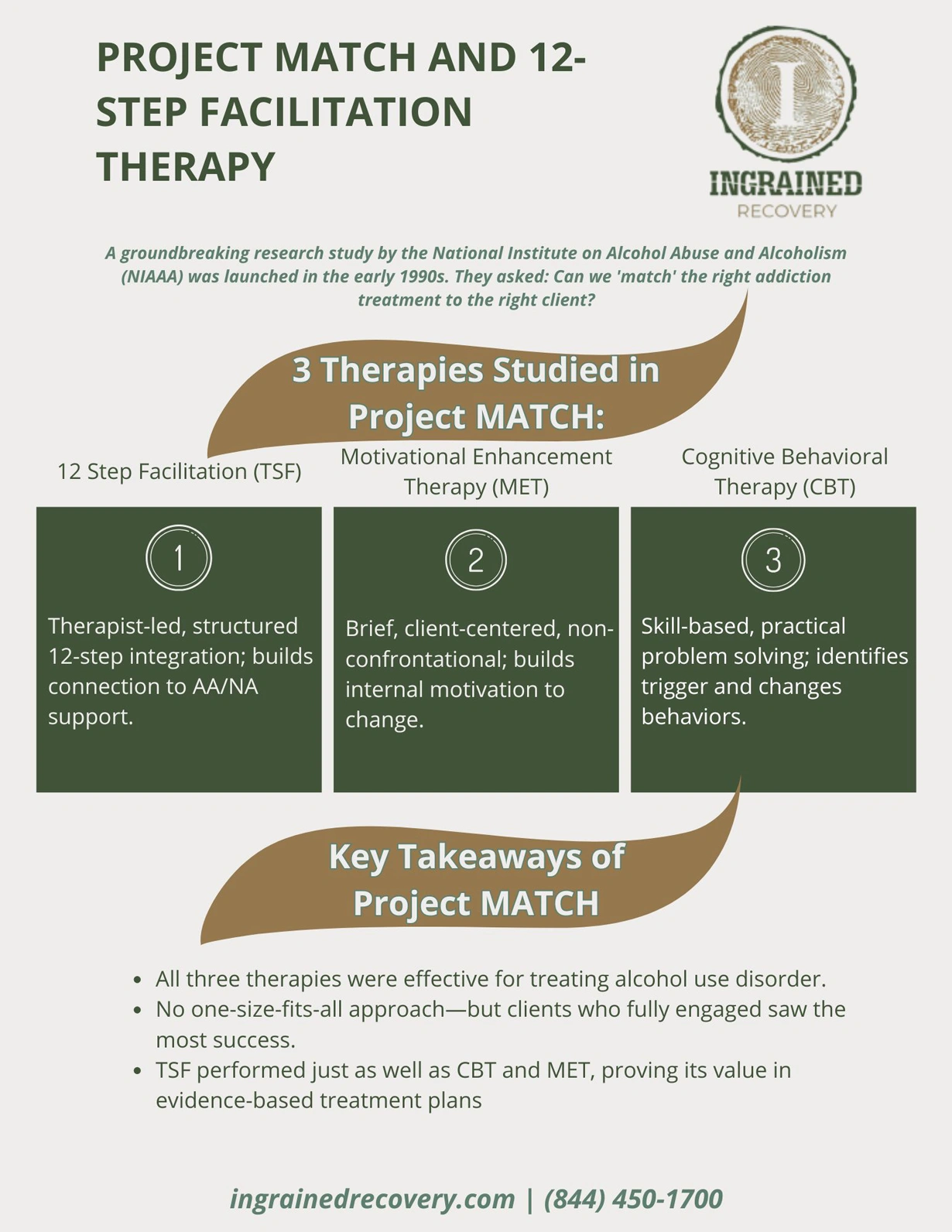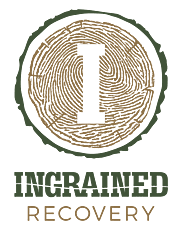Evidence-Based Methods of Guiding Clients in 12-Step Programs
What is 12-step facilitation therapy? This evidence-based and structured approach helps therapists guide clients through 12-step programs like Alcoholics Anonymous (AA) or Narcotics Anonymous (NA).
While the actual 12-step programs are peer-led groups, 12-step facilitation therapy is led by specially trained mental health professionals who guide them as they reap the spiritual and behavioral benefits of the program.
At Ingrained Recovery, we see great value in clients attending NA or AA meetings after graduating from a formal addiction treatment program. The peer support reinforces tools learned during the recovery process and assists with relapse prevention.
But what about the clients who would benefit from a Twelve-Step program but are skeptical? What about those who struggle to commit to regular meeting attendance? That’s where 12-Step facilitation therapy (TSF) steps in.
How 12-Step Facilitation Therapy Differs from Peer-Led AA Groups
Both the TSF model and AA groups (or similar groups, such as NA, Gamblers Anonymous, etc.) follow the same model, while serving the unique needs of their members. It is led by peers, free, and open to any person with substance abuse or alcohol dependence problems.
On the other hand, Twelve-Step Facilitation is an active engagement strategy designed to help clients understand and engage in the 12-step process. It is science-backed and usually integrated as part of a comprehensive treatment plan.
Our side-by-side comparison can help make the distinctions clearer:
Get Accredited Treatment Programs at Ingrained Recovery

Twelve-step Facilitation vs. Alcoholics Anonymous 12-Step Meetings
| FEATURE | 12-STEP FACILITATION THERAPY | ALCOHOLICS ANONYMOUS (AA) |
| Led by | Licensed therapist or addiction counselor | Peers who have struggled with addiction and treatment lead 12-step programs |
| Setting | Clinical: Residential rehab or outpatient center; therapist’s office | Community meeting space |
| Structure | Evidence-based treatment | Open format, which varies by group |
| Personalization | Tailored to meet client needs | One-size-fits-all; self-directed by participants |
| Use of the AA Big Book | Guided reading and structured discussions of drug and alcohol abuse | Self-help guide, used for shared reflections and group discussions |
| Accountability | Therapist guides and helps track goals | Personal responsibility |
| Encourages mental health services integration? | Yes | Usually not |
| Fee? | Yes – may be covered by insurance | Free and donation-based |
| Requires total abstinence? | No. Some clients step down using Medication Assisted Treatment programs, based on evidence | Yes |
No single treatment program or method is right for every person. When choosing which model would best suit your needs, ask yourself which 12-step method would best help you reach the goal of lasting recovery.
Get Proven Detox and Rehab Options at Ingrained

Twelve-Step Facilitation and Comprehensive Substance Abuse Treatment Plans
Twelve-step facilitation therapy is very effective in well-rounded addiction treatment plans, especially for clients who struggle with substance use disorder. Unlike the peer-led approach, TSF therapy provides personalized guidance through the program steps.
Clients may choose only to attend TSF therapy and skip peer groups. But the National Institute of Health (NIH) suggests that TSF is best used as a bridge to community-based Twelve-Step meetings, where they can receive peer support to help sustain recovery.
When combined with medical care, mental health services, and other programs, TSF can be a great tool, helping people make great strides in their recovery programs.
What Are the Twelve Steps of Alcoholics Anonymous?
Before we continue, let’s have a refresher on AA’s steps, per the organization’s website:
- “We admitted we were powerless over alcohol—that our lives had become unmanageable.
- Came to believe that a Higher Power greater than ourselves could restore us to sanity.
- Decided to turn our will and our lives over to the care of the Higher Power as we understood Him.
- Made a searching and fearless moral inventory of ourselves.
- Admitted to God, to ourselves, and to another human being the exact nature of our wrongs.
- Were entirely ready to have God remove all these defects of character.
- Humbly asked Him to remove our shortcomings.
- Made a list of all persons we had harmed, and became willing to make amends to them all.
- Made direct amends to such people wherever possible, except when to do so would injure them or others.
- Continued to take personal inventory, and when we were wrong, promptly admitted it.
- Sought through prayer and meditation to improve our conscious contact with God as we understood Him, praying only for knowledge of His will for us and the power to carry that out.
- Having had a spiritual awakening as the result of these steps, we tried to carry this message to alcoholics, and to practice these principles in all our affairs.”
Using the Big Book and Other12 Step Resources
TSF therapists often use the Big Book of Alcoholics Anonymous to help clients understand the foundational philosophy behind the 12 steps. Therapists recognize that the book contains powerful recovery stories and practical guidance relevant in a clinical setting.
For instance, the therapists may assign a “homework” assignment asking the client to read about powerlessness and then connect it to the idea of asking for and accepting help. The book can be particularly useful when people struggling with AA need more light shed on the basic concepts.
Additionally, other resources related to AA, NA, and other 12 step groups are part of our materials at Ingrained, including the following helpful guides:
Addressing Alcohol Use Disorder and Drug Abuse
Like twelve-step programs themselves, 12-Step facilitation therapy was first developed to help people with alcohol addiction. However, it’s now been adapted to help people overcome many drug addictions, including stimulants, opioids, prescription drug abuse, and other substances.
While working with a therapist, clients start considering the underlying thoughts, patterns, and behaviors that may have contributed to drug and alcohol addictions at a pace that suits their needs.
Three Core Concepts of 12-Step Facilitation Therapy

Project MATCH, an extensive study conducted by the National Institute on Alcohol Abuse and Alcoholism in the 1990s studied several specific therapies.
The Project Match report noted that TSF was equally as effective as cognitive behavioral therapy and motivational enhancement therapy – two time-proven treatment options for substance use.
The success of 12-step facilitation therapy lies in its three key concepts:
1) Acceptance of the Drug or Alcohol Addiction
Clients must admit that their drug and alcohol use is out of control. They learn that recovery is more than just willpower, setting themselves up for successful treatment.
2) Surrender and Accepting Support
Next, participants learn that they can’t manage addiction alone. Counselors challenge them to surrender to a supportive process. They may explore the principles of a Higher Power, peer connection, and professional guidance to support their recovery.
3) Active Involvement in 12-Step and Other Treatments
TSF success requires that clients show up and do the hard work of addiction recovery. They must attend appointments or meetings, complete therapy assignments, and take the steps seriously. Participating actively in the 12 steps builds momentum and helps clients regain confidence.
Step Work and Relapse Prevention
Doing the 12 steps promotes self-efficacy and empowers clients to continue following AA. In TSF, clients do the step work with the support of a therapist. The guided process helps those in recovery:
- Reflect on their past behaviors
- Make amends with family members and friends who have been hurt by addiction
- Build a healthier self-identity
- Explore the principles of spiritual growth
- Commit to 90 in 90 core practices
Therapists can integrate the step work with other aftercare strategies, including identifying triggers, coping skills, and building a support team. The step work translates into a real-world aftercare plan to protect sobriety after completing the 12 steps.
Mental Health Support within 12-Step Facilitation Therapy

The Centers for Disease Control and Prevention, CDC, has called mental health a public health issue. Many come to Ingrained Recovery for addiction treatment programs. But they learn they have underlying health issues that have led them to addiction – depression, PTSD, anxiety, or other disorders.
Attending TSF in a clinical setting allows recovery professionals to address co-occurring disorders at the same time they work on their 12-step programs. This approach helps ensure holistic well-being and minimizes relapse risks.
Up To 100% of Rehab Costs Covered By Insurance
Call Ingrained for Effective Addiction Treatment and Support
Ingrained Recovery offers clients more than 12-step facilitation therapy – that’s just one of many tools we have. But if you are interested in exploring the 12-step recovery model and need professional guidance, we can be the bridge that connects your program to integrated therapies and programs.
Reaching out to us is always free and confidential. Contact our admissions team today to get started.
